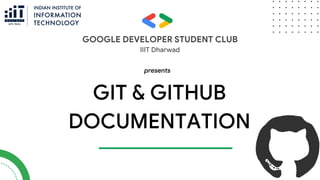GDSC GIT AND GITHUB
- 1. presents IIIT Dharwad GIT & GITHUB DOCUMENTATION GOOGLE DEVELOPER STUDENT CLUB
- 3. Git is a version-control-system and GitHub is a cloud platform which uses git to manage your codebase. Let’s say you’ve added a new feature in your app and it breaks the application for some reason. Now you want to go back in the past and get access to the previous version of your code where the app is running smoothly. This can be done by using Git! Also collaborations can be achieved via Git and GitHub :’)
- 4. Getting Started repository - The folder where you store your all code files Stuck anywhere in a repo? git status #-will show you the status of your repository
- 5. Start with a git project from scratch initializes a git repo in the folder- git init commit your changes- git add . # add files to the staging area git commit -m "some commit message" # commit the changes to the version git add? it basically adds all of your specified files into a staging area where the changes can be saved. revert this step - remove added files to the staging area git commit? it takes a photo of all the staged files and add this snapshot/version in the history.
- 6. Start with a git project from scratch push to github? using git stash stash the changes git stash this’ll put all the untracked and tracked changes to a stash area get back stashed changes git stash pop will bring back the changes clear the stash git stash clear
- 7. How to check all the versions of your code? log all the commits / versions git log to exit the log just type :q and hit enter go to a specific commit in history git revert commit_id get the commit_id from git log
- 8. Getting started with Github pip install <requirement r> [package-index- ns] ...python -m pip all [options] -r quirements file> [package- x-options] ...python -m [options] [-e] <vcs thon -m pip local ip
- 9. Getting Started with Github initialize a repo (new) here - https://github.com/new link this github repo to your local git repo get the git url copy the url from the new repo or just grab the url from the chrome url box link the repo git remote add some_name url some_name - the name to remote account accessing url - the url you copied from get the git url check all the remote repos attached git remote -v push the changes from your local to github git push some_name branch_name some_name - some_name - the name to remote account accessing branch_name - the branch you are currently at
- 10. Git Branching create a branch git branch branch_name go to a branch (branch_name) git checkout branch_name merge a branch let’s say you have two branches - main and feature you are in feature branch and you have to merge feature in main
- 11. Git Branching create a branch git branch branch_name go to a branch (branch_name) git checkout branch_name merge a branch let’s say you have two branches - main and feature you are in feature branch and you have to merge feature in main
- 12. making a pull request (pr) fork the repo from organization account to your account docs - https://docs.github.com/en/get-started/quickstart/fork-a-repo clone your repo locally git clone url docs - https://docs.github.com/en/repositories/creating-and-managing-repositories/cloning-a- repository make a branch for pr ref - create a branch with the feature name (it’s a convention) commit and push your changes of the new branch to your account commit changes - commit your changes push to github - push the changes from your local to github open github repo of your account and create a pr docs - https://docs.github.com/en/pull-requests/collaborating-with-pull-requests/proposing- changes-to-your-work-with-pull-requests/creating-a-pull-request
- 13. To stand out Make other’s life easy Project title & description Installation and run guides How to understand / use the project Credits / license Badges Contributing guidelines Tests, if they exist Why make a readme file / document your repo? Makes a good impression of your project and account things to include in a readme
